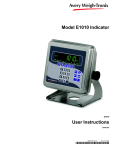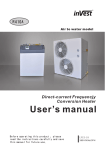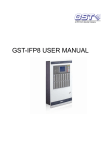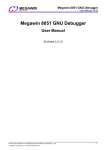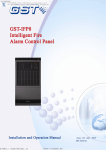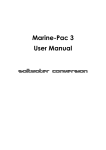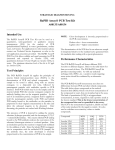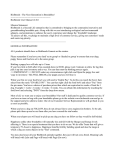Download to the PDF file.
Transcript
MPI Ignition System User’s Guide & Installation Manual September 1, 2004 MPI-04153A Effective 12/04 TABLE OF CONTENTS Section Page 1. Document Scope 2. System Description 3. System Component Mounting & Wiring 4. Programming 5. New Display Parameters 6. Start-up Procedures 7. Wiring Drawings 1 1 2 8 9 10 10 WARNING WARNING: DEVIATION FROM THESE INSTRUCTIONS COULD LEAD TO IMPROPER ENGINE OPERATION, WHICH COULD RESULT IN INJURY TO ALL NEARBY PERSONNEL AND EQUIPMENT DAMAGE. 1. Document scope This manual covers the following products: MPI-16D MPI-16 MPI-8D MPI-8 This document is intended to provide general guidelines for wiring to external equipment and power sources. Wiring instructions to specific Murphy products ( tachs, annunciators, valves, etc.) can be found in the previous MPI user manual. This document will describe the new displayed parameters that were developed specifically for this new design. 2. System description The MPI ignition system is a micro-processor based, capacitive discharge ignition system. The system can be used in a wide variety of sensor arrangements. The system also utilizes MPI coils that incorporate a patented sense lead feature that allows the system to measure spark plug voltage (KV). The voltage can be used to determine, 1. end of plug life, 2. compression stroke, 3. auto energy control, 4. coil/wiring/plug diagnostics. The new REV B design utilizes a single board that includes all of the electronics that was included in the REV A design that consisted of 4 modules for the MPI-16 and three modules for the MPI-8. The new design has provided the following improvements: 1. Lower operating power, requires less that 2 amps. This has resulted in much less heat dissipation internally. This improvement alone has greatly improved reliability. 2. Single board design has eliminated many internal cables this has reduced cost and increased reliability. 3. Second modbus port has improved performance. 4. Added a CAN port. 5. Reduced weight The system features crankshaft referenced timing within 0.25 degrees with as few as 30 events(pulses) from the crankshaft. The system is smart enough to track the flywheel rotation in between triggers while maintaining 0.25 degrees of accuracy. The timing can be adjusted while running through the easy to use display/keypad. The user can design his own speed-timing curve up to 5 points. The two 4/20mA inputs can be used to show a transducer parameter and if desired the 4/20 can also change the timing as a function of that sensor. This is also user configurable. MPI-04153A page 1 of 17 The unit is 100% field programmable from the display/keypad unit. No chips to program and install. No PC is required. MPI does have a PC based programming package available if that is desired. The system provides a wide array of diagnostic features both off-line and during engine operation. Off line diagnostics feature the ability to fire the coils to verify the primary harness is wired to the correct cylinder (firing order verification). Firing the coils/plugs also provides a means of verifying the coils and pugs are operating normally. The user can selectively turn the relays on & off to test those interfaces. The user can set the tank voltage to any desired level between 100-250 volts. On-line diagnostics include measurements of the input voltage, verification of the tooth(or hole) count, overspeed protection, many more useful parameters to give the user a fast and comprehensive look at what the system is doing. WARNING WARNING: THE MPI IGNITION SYSTEM MUST BE CONFIGURED (PROGRAMMED) PRIOR TO RUNNING THE ENGINE. REFER TO THE PROGRAMMING SECTION FOR INSTRUCTIONS. 3.0 System component mounting & wiring A basic system consists of an ignition controller with integral display, primary wiring harness, crankshaft and camshaft sensors, a coil for each spark plug. The controller comes in 2 basic configurations: MPI-16 which can directly drive up to 16 spark plug coils, and an MPI-8 which can drive up to 8 coils. Each of these controllers can come with an integrated display or can be purchased without the display. In the latter case the display can be purchased separately and mounted remotely. For engines that operate with 2 spark plugs per cylinder there is an MPI-32 which can directly drive two sets of coils up to 16 coils per set. There are a few engine models that fire two cylinders simultaneously and each cylinder uses two coils. In this case 4 coils are being fired at the same point. We recommend that two MPI-32’s be used in such an application. This section will show what each connection is for and how to use it. The connections are grouped according to function. Each group has a dedicated drawing. The following is a list of the interface groups. 1. Power Supply connections 2. MPI relay connections, a. Ignition ON relay b. Alarm relay c. Shutdown relay 3. Crankshaft and camshaft sensor arrangements 4. Switch inputs a. Ignition Enable b. A/B Select c. Alarm Acknowledge MPI-04153A page 2 of 17 5. “U” lead connections 6. 4/20 mA connections 7. Isolated repeater signals 8. Secondary comm. Port 9. Primary Harness connections 3.1 Power Source The MPI controllers require a nominal 24 Volt power source capable of delivering 3 amps. The full range for functional ignition is 12*-30 volts. * The display range is 18-30 volts, below 18 volts the display goes dark but the MPI ignition circuits will still function normally and at full power. Consideration should be given to the wire gauge and length. For short runs from the source (<15’), the power wires can be 18AWG min. For longer distances the voltage may droop at the controller end of the pair. Using 16AWG should preclude any significant voltage drop. For engines using electric starters it is best to run a dedicated pair direct from the battery to the MPI. The user may want to provide a power switch for the MPI. This is a recommended practice as it allows the user to turn off power to the MPI for maintenance safety. It is further recommended that external fusing (or circuit breakers) for the power wire are provided near the source. Refer to drawing 200858 for wiring details (Page 11). 3.2 Relay connections There are three relays for optional use. All use a form C arrangement that means there are a common, a normally open and a normally closed set of contacts. The current rating for all of these contacts is 2 amps cont. Refer to drawing 200859 (Page 11) for the wiring details. The relays are: 1. Ignition On relay: This relay energizes when the controller has recognized that the engine is cranking and the crankshaft signals (PIP & 1/REV) and CAMREF (if applicable) are within specs. This means that the PIP count is within the tolerance range specified in the engine data that was programmed. It also implies the CAMREF and 1/REV signals are in their correct relative alignment. At the same moment the relay comes on, the controller starts firing the coils. Normally., the N.O. contacts are used to turn on a fuel valve. Holding off fuel until the ignition comes on prevents excessive fuel build up in the engine prior to sparks. For applications where the coils provide the compression reference (camless mode), it is imperative that this relay keeps fuel off until ignition has begun. These contacts can be used to signal a PLC, turn on a light, whatever is needed. The N.O. contacts will close when the relay is energized. There is light indicator next to the relay that will illuminate when it’s energized. The displayed parameter on the first operator’s page will change from “IGN OFF” to “IGN ON” simultaneously when the relay is energized. MPI-04153A page 3 of 17 2. Alarm Relay: This relay energizes when the controller detects an alarm criteria that has been met. The cause of the alarm will show on the display. Many alarms are not considered reasons for shutting down the engine. For example, the input 24 volts may droop below the alarm threshold typically it is set for 20 volts. This alarm would routinely appear on systems with electric starters. No real problem and no corrective action would be required. If, however, this alarm appears during normal run time, that could be an early indicator that the charger is not maintaining the battery and corrective action can be taken before the battery discharges down to the point where the unit can no longer keep running. In addition to showing the alarm message the display will show an “ALARM ON” message on the first operator page. To clear the alarm the user can press the appropriate function key on the appropriate page, or use an external switch closure on the Alarm Acknowledge input. The contacts are provided for general-purpose use. They can be used to turn on lights directly or be used as a discrete input to a SCADA system etc. 3. Shutdown Relay: This relay energizes when the system has detected a serious “out of range” condition. For example, if the engine rpm exceeds the specified threshold for over speed, and the duration the rpm exceeding this speed has exceed the specified amount of time, the relay will energize. External devices use the change in the relay contacts to detect the ignition has ceased. The ignition controller itself will cease ignition and post a message on the first operator page that a shutdown occurred and the actual cause of the shutdown will appear on the next page under “Shutdowns & Alarms”. The shutdown relay will automatically reset when the controller detects that the rpm is zero. The shutdown message will remain posted on the second page until the engine is restarted and then it will show “No Shutdown” if everything is normal on the restart. 3.3 Crankshaft and camshaft sensor arrangements The user needs to decide upon which method the system will use to sense the crankshaft and camshaft (if applicable) position. It is critical that the method programmed matches the actual physical sensor configuration. There are 5 methods to choose from: 1. Method #1: Ring Gear and Camshaft sensor (refer drawing 200860 for wiring page 12). PIP signal: use gear teeth or holes in the flywheel. Range 30 to 360. Sensor: passive magnetic pickup. Model # 200203, part # 72700007 1/REV signal: a 0.25 “ dia. min. hole or ferrous stud located to generate a single pulse for each revolution of the crankshaft. It can be located from 15 degrees before TDC to 15 degrees after TDC. The user must program the controller with the actual angle when it occurs. Sensor: passive magnetic pick-up. Model # 200203 MPI ferrous stud: pn 72050051 Note: as an option under this method the 1/REV can be generated using a magnet (MPI pn 72050049 and MPI Hall-effect sensor 72700006 (1.8”) or 72700008 (6”). MPI-04153A page 4 of 17 CAMREF signal: This signal is required for 4-cycle engines only that will provide a reference for the compression stroke. Some part of the active duration of this pulse must overlap or be coincident with the 1/REV signal on the compression stroke. Sensor: MPI Hall-effect, pn 72700006/8, use with MPI magnet pin 72050049 (north pole polarity) or the magnetic pin 7270050 (south pole). The user must connect the appropriate signal wire iaw the magnet polarity. In addition: IT IS CRITICAL THAT THE CONTROLLER IS PROGRAMMED WITH THE CORRECT CAMREF SIGNAL POLARITY. FOR THE MPI HALL_EFFECT SENSORS, THE POLARITY IS ALWAYS “NEGATIVE”. FOR OTHER SENSORS THE USER MUST DETERMINE THE POLARITY AND PROGRAM THE CONTROLLER ACCORDINGLY. FAILURE TO DO THIS CORRECTLY WILL RESULT IN FIRING THE SPARK PLUGS ON THE EXHAUST STROKE. 2. Method #2: Crank Disk with Camshaft sensor. Refer to dwg. # 200861 (Page 12). This method utilizes an MPI disk that has magnets imbedded in it’s outer circumference. The disk mounts on the crankshaft and takes the place of the ring gear teeth or holes and the 1/REV hole or stud. There are various diameters of these disks available. Each disk has a unique number of magnets inserted into the circumference. The user must enter the number of magnets into the “ Number of PIPs” parameter. This method allows the crankshaft sensing to be accomplished with a high degree of accessibility to the disk and sensor. This method is used in applications because of the difficulty certain engines present when trying to locate and mount sensors for the ring gear methods. The disk magnets, as with all magnets, have a south pole end and a north pole end. The hall-effect sensing elements are selective to this magnetic polarity. All but one of the magnets are installed such that the south pole faces outward. The single magnet with the north pole facing out is used for the 1/REV signal. This magnet is stamped with an “R” next to it. The north pole pulse is also used by the controller as the last PIP pulse and performs those actions taken when normal PIP pulses are detected. The South pole magnets are used for generating PIP signals. The MPI hall-effect sensors p/n 200201-A ( 1.8”l) or the 200211(6”l) provide both a south pole pulse and a north pole pulse on separate output wires. Refer to drawing 200861 for wiring and mounting details. CAMREF signal is set up the same way as method #1. 3. Method #3: CAM Disk Method Refer to dwg. # 200862 (Page 13). This method utilizes a disk mounted directly onto the camshaft or a shaft running at synchronous speed with the camshaft. Since the disk is already at cam speed there is no need for a separate camshaft sensor. The “cam disk” provides the PIP and 1/REV signals with the single MPI dual hall-effect sensor. There are disks designed to “drop in” for certain engine applications. Included among those is the Waukesha VHP series, the Cat 3408 and 3412 engines. 4. Method #4: Ring gear teeth (or holes) and NO cam sensor. Refer to dwg. # 200864 (Page 14). This method is also referred to as a “camless” method. The PIP and 1/REV signals are set up as outlined in method #1. This method does not use a camshaft sensor. For determining the compression stroke the controller uses the “Smart coil” technology. The camless method uses the relationship between the pressure of the air in the spark plug gap and its affect on breakdown voltage. In simple terms the higher the pressure in the gap, MPI-04153A page 5 of 17 the higher the voltage requirement is to start the spark. Under the compression stroke the spark plug gap is subjected to a significantly higher pressure than it is during the exhaust stroke when the cylinder is at atmospheric pressure. The “KV” measurement shows this affect of the higher breakdown voltage required under the higher pressure. Using this cause and effect relationship, the controller program will test fire a number of coils when the engine first starts to crank. It saves all of the KV readings over four revolutions on each tested coil. Each coil fired during this testing phase has been fired twice during the compression stroke and twice during the exhaust stroke. The program then determines by evaluating the readings in the sequence they were read which two strokes were compression and which two were exhaust strokes. The result of this evaluation is the determination of the stroke type coming up on the 5th revolution. After this initialization the program keeps track of the stroke type by switching the stroke type with every 1/REV pulse. 5. Method #5: Crank Disk with NO cam sensor. Refer to dwg. # 200865 (Page 14). This method is similar to method #2 with the exception of the eliminated cam sensor. This is another “camless” based method and the compression stroke is determined as outlined in method #4. 3.4 Switch Inputs Refer to drawing 200863 for wiring details (Page 13). The MPI controller has three switch type inputs. 1. Ignition Enable : This input is used to enable or “kill” the ignition. When the connected switch contact (relay or manual switch) is open the ignition is allowed to run if everything else is operational. When the contacts close the controller will cease firing the coils and it will also shutdown the high voltage supply for the tank capacitors. If there is an ignition delay programmed the controller will wait for that specified amount of time before turning off the ignition. 2. A/B Select : The switch or relay contacts wired to this input will signal the controller to operate from either the A schedule (open) or switch over to the B schedule (closed). Leaving this input unwired will be treated as an open switch and the controller will run the timing and 4/20ma control according to the A schedule. 3. Alarm Acknowledge: The switch connected to this input can be used to clear any alarms in the queue and it will also release the MPI alarm relay if it is set. The same action can be done by selecting the page showing the alarms and pressing F2 on the keypad. 3.5 U lead connections Refer to drawing # 200866 for details (Page 15). The U lead refers to the primary harness connector pin identified by the letter “U”. This lead is used to supply CD power to end devices that typically run off the magneto “kill” lead. The U lead is internally connected to the odd firing tank capacitor, current limited through a series 30k ohm resistor. The same connection point is also brought over to the terminal TB-1B position 11. The normal connection to external devices is made in the primary harness itself on the actual U lead. The terminal can also be used and it’s also an easy point to observe the primary parade for the odd firing tank cap. The important concept to keep in mind when it is desired to use the U lead is that it’s reference in the “T” lead. The T lead is the negative side of the tank capacitor. It is typically connected to all the coils (-) terminal. IF a CD powered device is used it typically references engine ground. Therefore in order for the U lead to supply power to a device that is ground referenced the T lead must also be connected to the same ground as the device. Refer to the drawing for this connection. MPI-04153A page 6 of 17 The U lead can also be used for the “kill” function. If this lead is grounded it will disable ignition similar to the Ignition Enable switch input. The system will display the same message i.e. “Ignition Disabled” when the U lead is grounded. 3.6 4/20mA Connections Refer to drawing # 200871 for details (Page 17). The MPI controllers have two 4/20 mA interfaces. One is associated with schedule A and one with schedule B. There is also an option to assign the channel A 4/20mA interface to affect schedule B timing. Each input is ground referenced therefore it is considered to be an “end of line” device. Each input has an internal 250 ohm resistive termination. If a voltage source is used, a 1-5 volt input will have the same affect as a 4/20mA driver. 3.7 Isolated Repeater Signals Refer to drawing # 200870 for wiring details (Page 17). The three signals, PIP, 1/REV, and CAMREF are provided through an opto-isolated driver chip for use by external equipment. The isolation provides for allowing a shorted condition on these outputs without affecting that actual signals coming in from the respective sensors used by the MPI for running the ignition. 3.8 Secondary Comm Port Refer to drawing #200867 (Page 15). The secondary communication RS-485 port protocol is a Modbus Slave type. The baud rate is fixed at 9600. The slave ID can be set through the primary port and MPI display. All parameters (other than the slave ID) and features that are accessible through the primary port and MPI display are available on the secondary port as well. 3.9 Primary harness connections Refer to drawing # 200868and 200869 for wiring details (Page 16). 3.9.1 MPI-16 Harnesses The MPI-16 primary harness contains 19 wires. This includes 16 coil outputs, a common coil return (T lead), a tank capacitor output for powering CD devices (U lead), and an input diagnostic sense lead (V lead). The sense lead can be run in the same conduit with the coil leads. The firing sequence in this harness is always: A,B,C,D. The user must connect this sequence to the proper cylinder in accordance with the firing order. This firing pattern in the harness i.e. A,B,C,D.. is NOT configurable through the display, this is the sequence of all MPI-16 units. As an example, lets say an engine has a firing order of :1,2,15,16,7,8. The harness should be wired as follows: Pin Color Code Cylinder A Brown 1 B White/brown 2 C Red 15 D White/red 16 E Orange 7 F White/orange 8 And so on. MPI-04153A page 7 of 17 3.9.2 MPI-8 Harnesses This harness contains 11 leads. Eight are coil outputs, then then the T,U, & V leads as in the MPI-16 harness. There is a significant difference in the firing sequence of the MPI-8 harnesses. The harness fires in the sequence as follows: A,C,E,G,J,L,N,R For example, an engine with the firing order of : 1,8,4,3,6,5,7,2 would be wired as follows: Pin Color Cylinder A Brown 1 C Red 8 E Orange 4 G Yellow 3 J Green 6 L Blue 5 N Violet 7 R Grey 2 4. Programming Programming the MPI controllers for specific applications is accomplished by two means: 1. Programming through the display keypad unit. 2. Using a PC and MPI Prog software Prior to programming the unit must be in the Standby mode (engine rpm = 0). Select the “Programming Page” option (F4) from the main menu. Then press F2 “View/Edit”. This should result in the display showing the first page of the crankshaft selections. Scroll through until the desired crankshaft is seen and press the associated “F” key. By selecting the crankshaft the angles and number of cylinders is obtained. The display will automatically switch to show the actual crank angles in degrees between the tdc points of each cylinder. Scroll one page to the right to show the Schedule A timing curve information. At least one timing point needs to be entered. If the 4/20mA input is to be used for timing retard control the user would enter this information on this page. Note: the 4/20mA input is shown during operation even if no timing retard curve is entered. This allows the user to simply observe a transducer’s output without affecting the timing. The display file can be modified to scale the 4/20mA into some engineering unit for ease of reading. For example, if a temperature transducer is being used the display can be programmed to readout the temperature instead of the 4/20mA level or both. Next, the user must scroll to the “Misc Parameter” page and at a minimum, fill in the following: 1. Crank method 2. PIPs per rev 3. Overspeed RPM 4. Coil type 5. CAM polarity (if applicable) MPI-04153A page 8 of 17 All of the other parameters are filled in only if they are needed by the application. Further details on these parameters can be obtained from the previous version of the MPI Installation manual dated Sept. 2000. 5.0 New Display Parameters During the development of the new single board controller there were several new parameters added to the system that appear on the display. Most of them are intended for use by factory engineers to help with field support. A brief description is provided here. Page 2 additional parameters: 1. CD 1/REV Position: this parameter indicates how centered the 1/REV signal is wrt the adjacent PIP pulses. Its important that this shows between 90-100% which means the 1/REV signal is fairly centered. If it shows 60-90% the timing accuracy will be degraded. This is only critical for the crank method of Crank Disk w&wo cam 2. Flash Status & Checksum: When the user saves the engine data the status line will indicate if the programming process completed successfully. A checksum value is calculated and is check on every power up. If the engine data gets corrupted the checksum on power up will not match the checksum made during the save operation and a message will be posted for this error. 3. DBG1 & DBG2: These parameters are used to show internal variables if a problem comes up that needs to be looked into at such a depth. We can assign various variables to these parameters on a “as-needed” basis. They are only used during the troubleshooting process and currently are not in use. 4. 1/Rv timestamps: These parameters are updated at each occurrence of a 1/REV pulse. They are the number of internal clock ticks counted between 1/REV pulses. If a 1/REV pulse is detected that is not from the 1/REV target the parameter will show a smaller number of clock ticks. Using this information we can determine in the case if a bad PIP count which signal was at fault, the PIP or the 1/REV. The last 5 cycles are saved. Page 4. 1. KVSCF: This parameter is a calibration factor that is set at the factory but may be further adjusted in the field if necessary. It corrects for the propagation delays of the sense signal through all of the electronic components. Each production board can have slight differences in their component delays so this parameter is used to make sure the KV readings are accurate for each bd. Sometime the field wiring can also add delays so this parameter can be used to compensate for long harnesses. 2. KV Termination: This parameter is either “IN” or “OUT” and it tells the processor to switch on the termination hardware on the sense lead. This termination is helpful for shielded system where an excessive amount of primary voltage can be induced on to the sense lead. The termination helps to reduce that induced voltage. Field testing determines if it is needed. But generally, shielded systems use it, unshielded systems typically do not benefit by it. 3. SecThres: This parameter adjusts a reference voltage within the sense signal interface circuitry. It used to be established with a small potentiometer in the older design. Now the voltage is set through the panel. This number is set at the factory and is typically set between 3-4 volts. Changing this parameter in the field should only be attempted by specially trained technicians that have a thorough understanding of the functionality of this parameter. MPI-04153A page 9 of 17 Page 6. On this page all of the test values for camless operation are shown. On the older model only a few values were shown. There is no difference between the old and new system in terms of these value’s meaning. 6.0 Start up procedures The start up procedures have not changed from the previous instructions. They are summarized here: 1. Program the unit for the specific application. 2. When the wiring is complete check the firing order using the KV diagnostic capability. 3. Perform a dry-run (no fuel) crank and check for ignition coming on. 4. When step 3 is successful, perform a start up with fuel. 5. While the engine is not loaded check the timing for stability and accuracy. 6. When step 5 is satisfied, operate at normal load. 7. Wiring Drawings No. 200858 200859 200860 200861 200862 200863 200864 200865 200866 200867 200868 200869 200870 200871 Title DC Power Source Relay Interface Method 1, Ring Gear w/ Cam Sensor Method 2, Crank Disk w/ Cam Sensor Method 3, CAM Disk Switch Inputs Method 4, Ring Gear w/o Cam Sensor Method 5, Crank Disk w/o Cam Sensor U lead wiring Secondary Modbus Port MPI-8 Primary Harness MPI-16 Primary Harness Repeater Signals (PIP, 1/REV, CAMREF) 4/20 mA Interface MPI-04153A page 10 of 17 Drawing #200858 REGULATOR BATTERY ALTERNATOR TB-1A BATTERY CHARGER SWITCH RATING 10 AMP MIN. BATTERY 24 VDC INPUT FUSE RATING 10 AMP 24 VDC RETURN POWER SUPPLY EARTH GROUND POWER SUPPLY SPEC: 5 AMP CONTINUOUS 1. IT IS RECOMMENDED THAT EACH SYSTEM BE CONNECTED SPERATELY BACK TO THE POWER SOURCE. USE CHART 1 TO DETERMINE THE WIRE SIZE (GAUGE) REQUIRED. IGNITION RELAY N.O. IGNITION RELAY COM IGNITION RELAY N.C. ASA SN SN 9/14/04 2/1 DC Power Source 200858 Drawing #200859 * FUEL SOLENOID VALVE TB-1A +24 + +24 24 VDC INPUT 24 VDC RETURN EARTH GROUND 24 AMPS MAX PLC IGNITION RELAY N.O. IGNITION RELAY COM LAMP 24 VDC IGNITION RELAY N.C. +24 24 AMPS MAX ALARM RELAY N.O. ALARM RELAY PLC COM ALARM RELAY N.C. LAMP 24 VDC 24 AMPS MAX SHUTDOWN RELAY N.O. SHUTDOWN RELAY COM +24 SHUTDOWN RELAY N.C. PLC ASA ANNCIATOR SWITCH INPUT SN SN * REQUIRED USE FOR ANY "CAMLESS" APPLICATIONS 9/16/04 1/1 RELAY INTERFACE 200859 MPI-04153A page 11 of 17 Drawing #200860 TB-1B SHIELD CAM SUPPLY PWR (BROWN) 1 S N +12 VDC CAM SIGNAL CAM REF N-POLE (WHITE) 2 4 3 CAM RETURN IGN_EN (SW) S-POLE N/C (BLACK) SWITCH RETURN RTN (BLUE) AB_SEL (SW) A TB-1C HALL SUPPLY (12V) B PIP SIGNAL 1/REV HOLE OR STUD PIP RTN A SHIELD 1/REV RTN B Signal Alignment ASA SN SN 9/20/04 2/1 STEP 1) Install 1/REV to within ±15° of TDC #1 cycle STEP 2) Install CAM sensor/magnet; select sensor location so magnet is aligned with CAM sensor when 1/REV target hole (stud) is aligned with 1/REV sensor METHOD #1 RING GEAR W/ CAM SENSOR 200860 Drawing #200861 TB-1B SHIELD 1 2 3 4 S N PWR (BROWN) CAM SUPPLY (12V) +12 VDC CAM SIGNAL N-POLE (WHITE) CAM REF CAM RETURN IGN_EN (SW) N/C (BLACK) SWITCH RETURN RTN (BLUE) AB_SEL (SW) TB-1C (BROWN) R HALL SUPPLY (12V) H A L L S UP P L Y PIP SIGNAL PIP PIP RETURN 1 SHIELD 2 3 1/REV (WHITE) 4 1/REV SIGNAL (TDC) 1/REV RETURN (BLACK) SHIELD Signal Alignment (BLUE) RTN ASA SN SN 9/22/04 2/1 METHOD #2 CRANK DISK W/ CAM SENSOR 200861 MPI-04153A page 12 of 17 Drawing #200862 TB-1C HALL SUPPLY (12V) PIP SIGNAL PIP RETURN SHIELD 1 2 3 4 R (BROWN) HALL SUPPLY (WHITE) 1/REV SIGNAL (TDC) 1/REV (BLACK) 1/REV RETURN PIP (BLUE) RT N SHIELD 4-20 mA ChA+ 4-20 mA ChA- SIGNAL ALIGNMENT 4-20 mA ChB+ 1/REV 4-20 mA ChB- SHIELD TDC #1 COMP COMP EXH ASA SN SN PIP 9/22/04 2/1 * ALIGN 1/REV TO TDC #1 COMPRESSION METHOD #3 CAM DISC 200862 Drawing #200863 SWITCH CONFIGURATIONS TB-1B SHIELD RELAY CONTACT CAM SUPPLY (12V) +12 CAM SIGNAL CAM RETURN MANUAL SWITCH 3K IGN_EN (SW) SWITCH RETURN BIPOLAR TRANSISTOR DRIVE SAME AS IGN_EN AB_SEL (SW) SWITCH RETURN ALARM_ACK(SW) SAME AS IGN_EN MOSFET TRANSISTOR DRIVE SWITCH RETURN U-LEAD SPARE ASA SN SN 9/23/04 2/1 SWITCH INPUT 200863 MPI-04153A page 13 of 17 Drawing #200864 TB-1C HAL L SUP PL Y (12V) PIP SIGNAL PIP SENSOR A PIP RETURN B 1/REV SIGNAL (TDC) SHIELD 1/REV 1/REV RETURN A SHIELD 4-20 mA ChA+ B 4-20 mA ChA- 1/REV OPTION 1 2 3 4 S N FLYWHEEL PWR (BROWN) +12 VDC 4-20 mA ChB+ 4-20 mA ChB- (WHITE) SHIELD MPI HALL EFFECT RTN (BLUE) ASA SN SN 9/24/04 2/1 METHOD #4 RING GEAR NO CAM SENSOR 200864 Drawing #200865 TB-1C (BROWN) 1 2 3 R 4 HALL SUPPLY (12V) (WHITE) PIP SIGNAL (BLUE) (BLACK) PIP RE T UR N SHIELD SHIELD 1/REV SIGNAL (TDC) 1/REV RETURN SHIELD 4-20 mA ChA+ ASA SN SN 9/24/04 2/1 METHOD #5 CRANK DISK NO CAM 200865 MPI-04153A page 14 of 17 Drawing #200866 A B C D E F G H J K L M N P R S T U V TB-1B SHIELD CAM SUPPLY (12V) CAM SIGNAL CAM RETURN IGN_EN (SW) SWITCH RETURN AB_SEL (SW) SWITCH RETURN ALARM_ACK(SW) SWITCH RETURN U-LEAD COIL #1 + COIL #16 + ALL COIL (-) TERM * SENSE LEAD TACH SPARE * Must Be Grounded For Proper Tach Operation CD GND (OPTIONAL) ASA SN SN 10/01/04 U LEAD WIRING 1/1 200866 Drawing #200867 TB-6 CAN- TERM CAN- MODBUS MASTER CAN+ SHIELD SHIELD DATA DATA _ + + RS-485 ASA SN SN 10/01/04 1/1 SECONDARY RS-485 PORT MODBUS SLAVE 200867 MPI-04153A page 15 of 17 Drawing #200868 A B C D E F G H J K L M N P R S T U V BROWN N/C RED N/C ORANGE N/C YELLOW N/C GREEN N/C BLUE N/C VIOLET N/C GREY S + _ + _ N/C + _ S + _ S + _ S S + _ + _ S S + _ S BLACK WHITE (Refer to drawing 200866) * WHITE / BLACK * TE RM I NA TO R PART# 200614 ASA SN SN MPI-8 PRIMARY HARNESS 10/04/04 1/1 200868 Drawing #200869 A B C D E F G H J K L M N P R S T U V BROWN WHITE / BROWN RED WHITE / RED ORANGE WHITE / ORANGE YELLOW WHITE / YELLOW GREEN WHITE / GREEN BLUE WHITE / BLUE VIOLET WHITE / VIOLET GREY COIL _+ S COIL +_ S COIL +_ S COIL _+ S COIL _+ S COIL _+ S COIL _+ S COIL +_ S COIL +_ S COIL _+ S COIL _+ S COIL _+ S COIL _+ S COIL +_ S COIL +_ S WHITE / GREY COIL BLACK _ + S WHITE (Refer to drawing 200866) * WHITE / BLACK ASA * TE RM I NA TO R PART# 200614 SN SN 10/04/04 1/1 MPI-16 PRIMARY HARNESS 200869 MPI-04153A page 16 of 17 Drawing #200870 VDC IL RL + CAM + VDC CAM _ CAM -- + PIP + VDC PIP _ PIP -- + 1/REV + 1 / REV _ 1/REV -- TB-4 NOTE : VDC RANGE 5-30 VDC IL MAX = 1mA ASA SN SN 10/06/04 1/1 REPEATOR SIGNALS 200870 Drawing #200871 TB-1C 4/20 TRANSDUCER 1/REV RETURN +24 SHIELD 4-20 mA ChA+ 250 4-20 mA ChA- 4/20 TRANSDUCER +24 4-20 mA ChB+ 250 4-20 mA ChB- (O P TIO NA L) SHIELD KNOCK SENSORS MPI DSI ASA SN SN 10/08/04 1/1 4/20 mA INTERFACE 200871 MPI-04153A page 17 of 17






















